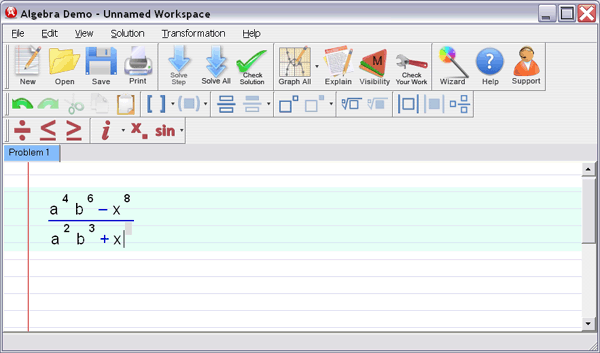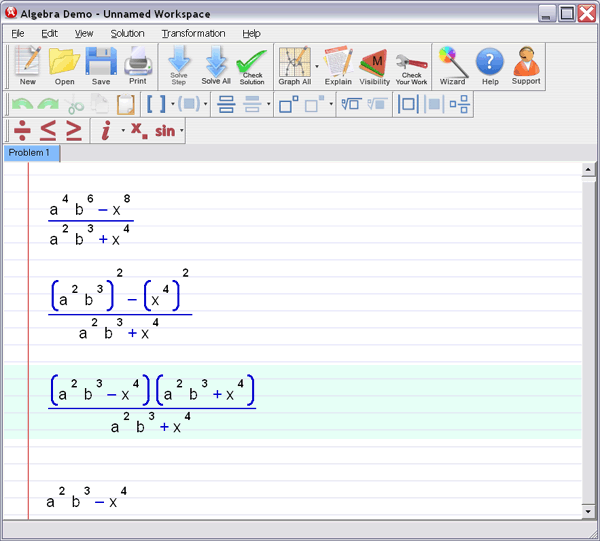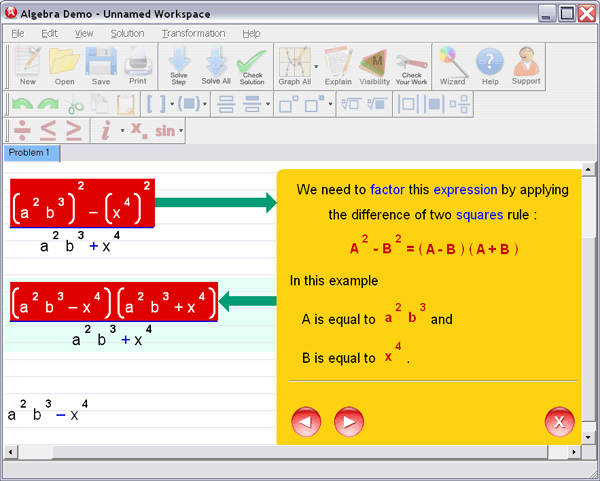Grade 5 Grade-Level Goals
|
|
| Grade-Level Goals |
Content Thread |
Program Goal |
Goal 1
Read and write whole numbers and decimals; identify places in such
numbers and the values of the digits in those places; use expanded
notation to represent whole numbers and decimals. |
Place value and notation |
Understand the Meanings, Uses, and
Representations of Numbers |
Goal 2
Solve problems involving percents and discounts; describe and explain
strategies used; identify the unit whole in situations involving
fractions. |
Meanings and uses of fractions |
Goal 3
Identify prime and composite numbers; factor numbers ; find prime
factorizations. |
Number theory |
Goal 4
Use numerical expressions involving one or more of the basic four
arithmetic operations , grouping symbols, and exponents to give
equivalent names for whole numbers; convert between base-10,
exponential, and repeated-factor notations. |
Equivalent names for whole numbers |
Understand Equivalent Names for
Numbers |
Goal 5
Use numerical expressions to find and represent equivalent names for
fractions decimals, and percents; use and explain multiplication and
division rules to find equivalent fractions and fractions in simplest
form; convert between fractions and mixed numbers; convert between
fractions, decimals, and percents. |
Equivalent names for fractions, decimals, and
percents |
Goal 6
Compare and order whole numbers up to 1,000,000,000 and decimals through
thousandths; compare and order integers between -100 and 0; use area
models, benchmark fractions, and analyses of numerators and denominators
to compare and order fractions. |
Comparing and ordering numbers |
Understand Common Numerical Relations |
|
|
| Grade-Level Goals |
Content Thread |
Program Goal |
Goal 1
Use mental arithmetic, paper-and-pencil algorithms, and calculators to
solve problems involving the addition and subtraction of whole numbers,
decimals, and signed numbers; describe the strategies used and explain
how they work. |
Addition and subtraction procedures |
Computes Accurately |
Goal 2
Demonstrate automaticity with multiplication facts and proficiency with
division facts and extensions. |
Multiplication and division facts |
Goal 3
Use mental arithmetic, paper-and-pencil algorithms, and calculators to
solve problems involving the multiplication of whole numbers and
decimals and the division of multidigit whole numbers and decimals by
whole numbers; express remainders as whole numbers or fractions as
appropriate; describe the strategies used and explain how they work. |
Multiplication and division procedures |
Goal 4
Use mental arithmetic, paper-and-pencil algorithms, and calculators to
solve problems involving the addition and subtraction of fractions and
mixed numbers; describe the strategies used and explain how they work. |
Procedures for addition and subtraction of
fractions |
Goal 5
Use area models, mental arithmetic, paper-and-pencil algorithms, and
calculators to solve problems involving the multiplication of fractions
and mixed numbers; use diagrams, a common-denominator method, and
calculators to solve problems involving the division of fractions;
describe the strategies used. |
Procedures for multiplication and division of
fractions |
Goal 6
Make reasonable estimates for whole number and decimal addition,
subtraction, multiplication, and division problems and fraction and
mixed number addition and subtraction problems; explain how the
estimates were obtained. |
Computational estimation |
Make Reasonable Estimates |
Goal 7
Use repeated addition, arrays, area, and scaling to model multiplication
and division; use ratios expressed as words, fractions, percents, and
with colons; solve problems involving ratios of parts of a set to the
whole set. |
Models for the operations |
Understand Meanings of Operations |
Content Strand: Data and Chance
|
| Grade-Level Goals |
Content Thread |
Content Thread |
Goal 1
Collect and organize data or use given data to create bar, line, and
circle graphs with reasonable titles, labels, keys, and intervals. |
Data collection and representation |
Select and Create Appropriate Graphical
Representations of Collected or Given Data |
Goal 2
Use the maximum, minimum, range, median, mode, and mean and graphs to
ask and answer questions, draw conclusions , and make predictions. |
Data analysis |
Analyze and Interpret Data |
Goal 3
Describe events using certain, very likely , likely, unlikely, very
unlikely, impossible and other basic probability terms; use more likely,
equally likely, same chance, 50-50, less likely, and other basic
probability terms to compare events; explain the choice of language. |
Qualitative probability |
Understand and Apply Basic Concepts
of Probability |
Goal 4
Predict the outcomes of experiments, test the predictions using
manipulatives, and summarize the results ; compare predictions based on
theoretical probability with experimental results; use summaries and
comparisons to predict future events; express the probability of an
event as a fraction, decimal, or percent. |
Quantitative probability |
Content Strand: Measurement and Reference Frames
|
| Grade-Level Goals |
Content Thread |
Program Goal |
Goal 1
Estimate length with and without tools; measure length with tools to the
nearest 1/8 inch and millimeter; estimate the measure of angles with and
without tools; use tools to draw angles with given measures. |
Length, weight, and angles |
Understand the Systems and Processes
of Measurement; Use Appropriate Techniques, Tools, Units, and Formulas
in Making Measurements |
Goal 2
Describe and use strategies to find the perimeter of polygons and the
area of circles; choose and use appropriate formulas to calculate the
areas of rectangles, parallelograms, and triangles, and the volume of a
prism; define pi as the ratio of a circle’s circumference to its
diameter. |
Area, perimeter, volume, and
capacity |
Goal 3
Describe relationships among U.S. customary units of length; among
metric units of length; and among U.S. customary units of capacity. |
Units and systems of measurement |
Goal 4
Use ordered pairs of numbers to name, locate, and plot points in all
four quadrants of a coordinate grid . |
Coordinate systems |
Use and Understand Reference Frames |
Content Strand: Geometry
|
| Grade-Level Goals |
Content Thread |
Program Goal |
Goal 1
Identify, describe, compare, name, and draw right, acute, obtuse,
straight, and reflex angles; determine angle measures in vertical and
supplementary angles and by applying properties of sums of angle
measures in triangles and quadrangles. |
Lines and angles |
Investigate Characteristics and
Properties of Two - and Three-Dimensional Geometric Shapes |
Goal 2
Describe, compare, and classify plane and solid figures using
appropriate geometric terms; identify congruent figures and describe
their properties. |
Plane and solid figures |
Goal 3
Identify, describe, and sketch examples of reflections, translations,
and rotations. |
Goal 3
Identify, describe, and sketch examples of reflections, translations,
and rotations. |
Apply Transformations and Symmetry in Geometric
Situations |
Content Strand: Geometry
|
| Grade-Level Goals |
Content Thread |
Program Goal |
Goal 1
Identify, describe, compare, name, and draw right, acute, obtuse,
straight, and reflex angles; determine angle measures in vertical and
supplementary angles and by applying properties of sums of angle
measures in triangles and quadrangles. |
Lines and angles |
Investigate Characteristics and
Properties of Two- and Three-Dimensional Geometric Shapes |
Goal 2
Describe, compare, and classify plane and solid figures using
appropriate geometric terms; identify congruent figures and describe
their properties. |
Plane and solid figures |
Goal 3
Identify, describe, and sketch examples of reflections, translations,
and rotations. |
Transformations and symmetry |
Apply Transformations and Symmetry in Geometric
Situations |
Content Strand: Patterns, Functions, and Algebra
|
| Grade-Level Goals |
Content Thread |
Program Goal |
Goal 1
Extend, describe, and create numeric patterns; describe rules for
patterns and use them to solve problems; write rules for functions
involving the four basic arithmetic operations; represent functions
using words, symbols, tables, and graphs and use those representations
to solve problems. |
Patterns and functions |
Understand Patterns and Functions |
Goal 2
Determine whether number sentences are true or false; solve open number
sentences and explain the solutions; use a letter variable to write an
open sentence to model a number story; use a pan-balance model to solve
linear equations with one unknown. |
Algebraic notation and solving number sentences |
Use Algebraic Notation to Represent
and Analyze Situations and Structures |
Goal 3
Evaluate numeric expressions containing grouping symbols and nested
grouping symbols; insert grouping symbols and nested grouping symbols to
make number sentences true; describe and use the precedence of
multiplication and division over addition and subtraction. |
Order of operations |
Goal 4
Describe and apply properties of arithmetic. |
Properties of the arithmetic operations |
Start solving your Algebra Problems
in next 5 minutes!
 |
 |
 |
|
Algebra Helper
Download (and optional CD)
Only $39.99
|
|
Click to Buy Now:
OR
|
|
|
 |
 |
 |
|
2Checkout.com is an authorized reseller
of goods provided by Sofmath
|
|
Attention: We are
currently running a special promotional offer
for Algebra-Answer.com visitors -- if you order
Algebra Helper by midnight of
February 5th
you will pay only $39.99
instead of our regular price of $74.99 -- this is $35 in
savings ! In order to take advantage of this
offer, you need to order by clicking on one of
the buttons on the left, not through our regular
order page.
If you order now you will also receive 30 minute live session from tutor.com for a 1$!
|
You Will Learn Algebra Better - Guaranteed!
Just take a look how incredibly simple Algebra Helper is:
Step 1
: Enter your homework problem in an easy WYSIWYG (What you see is what you get) algebra editor:

Step 2 :
Let Algebra Helper solve it:

Step 3 : Ask for an explanation for the steps you don't understand:

Algebra Helper can solve problems in all the following areas:
- simplification of algebraic expressions (operations
with polynomials (simplifying, degree, synthetic division...), exponential expressions, fractions and roots
(radicals), absolute values)
- factoring and expanding expressions
- finding LCM and GCF
-
(simplifying, rationalizing complex denominators...)
- solving linear, quadratic and many other equations
and inequalities
(including basic logarithmic and exponential equations)
- solving a system of two and three linear equations
(including Cramer's rule)
- graphing curves (lines, parabolas, hyperbolas, circles,
ellipses, equation and inequality solutions)
- graphing general functions
- operations with functions (composition, inverse, range, domain...)
- simplifying logarithms
- basic geometry and trigonometry
(similarity, calculating trig functions, right triangle...)
- arithmetic and other pre-algebra topics
(ratios, proportions, measurements...)
ORDER NOW!
 |
 |
 |
|
Algebra Helper
Download (and optional CD)
Only $39.99
|
|
Click to Buy Now:
OR
|
|
|
 |
 |
 |
|
2Checkout.com is an authorized reseller
of goods provided by Sofmath
|
|
|
 |
| |
| "It
really helped me with my homework. I was
stuck on some problems and your software walked me
step by step through the process..." |
| C. Sievert, KY
| |
| |
 |
| |
Sofmath
19179 Blanco #105-234
San Antonio, TX 78258
|
Phone:
(512) 788-5675
Fax: (512) 519-1805
| | |



